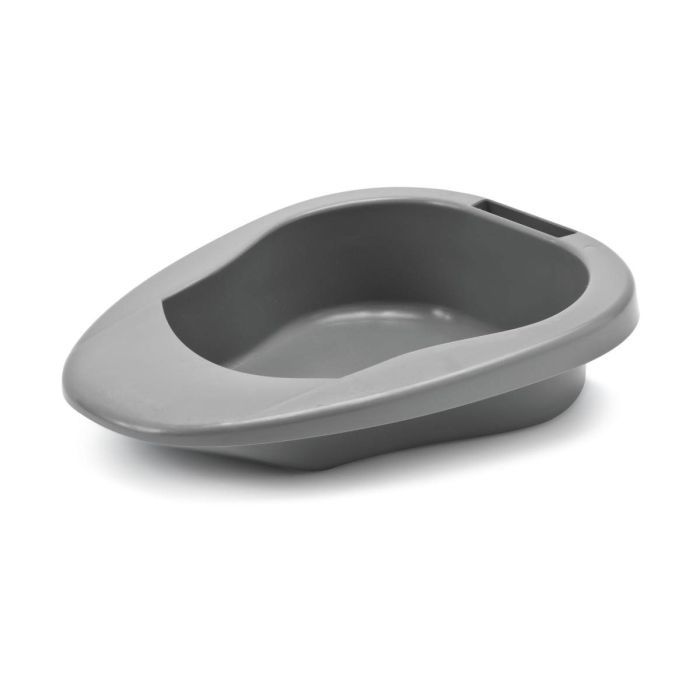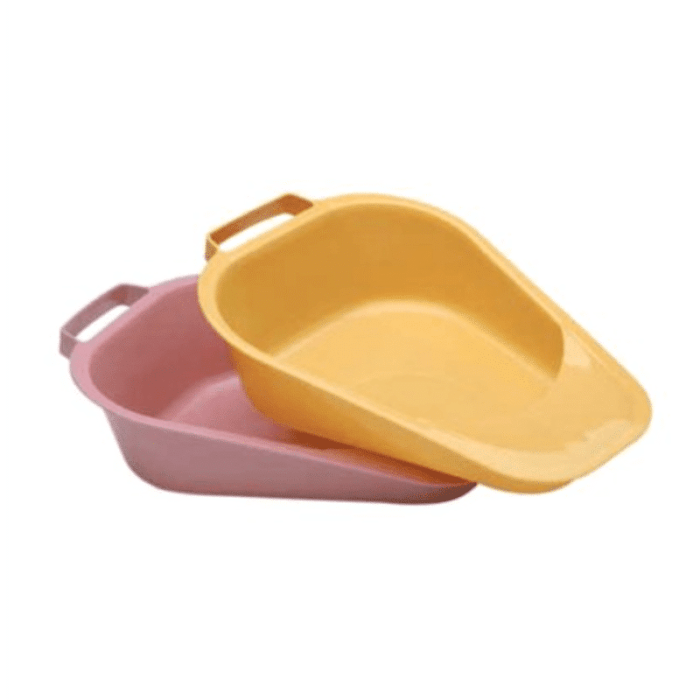Introducing the fracture bedpan front and back, an essential aid for patients with limited mobility. Its unique design provides comfort, support, and convenience, making toileting easier and more dignified.
From its specialized features to proper usage and maintenance, this guide will delve into the intricacies of fracture bedpans, ensuring you have all the necessary information at your fingertips.
Fracture Bedpan: Overview

A fracture bedpan is a specialized medical device designed to assist patients with limited mobility due to fractures, injuries, or other conditions that restrict their movement. It is a crucial aid in maintaining hygiene and comfort for individuals who are unable to use a regular toilet.
paragraphFracture bedpans are typically made of durable plastic or metal and feature a unique shape and design. They are designed to fit comfortably under the patient’s buttocks, providing support and allowing for easy waste elimination while lying down. The front and back sections of the bedpan are connected by a handle that enables the caregiver to securely position and remove the device.
Types of Fracture Bedpans
There are several types of fracture bedpans available, each designed to meet specific needs:
- Standard Fracture Bedpan:The most common type, designed for general use and suitable for most patients.
- Elevated Fracture Bedpan:Features elevated sides to provide additional support and comfort for patients with back or hip injuries.
- Commode Fracture Bedpan:A combination of a bedpan and a commode, allowing patients to sit upright while using the device.
- Pediatric Fracture Bedpan:Specially designed for children, with a smaller size and a more comfortable shape.
Fracture Bedpan: Front

The front portion of a fracture bedpan is designed to provide support and comfort to patients with hip or leg injuries who are unable to use a regular toilet. It features a contoured shape that fits snugly against the patient’s body, providing stability and preventing them from sliding off.
Front Design
The front of the fracture bedpan is typically made of a durable plastic material that is easy to clean and disinfect. It has a raised rim around the edges to prevent spills and a smooth, non-porous surface to minimize the risk of skin irritation.
The front portion also includes a handle or grip for easy handling and positioning.
Facilitation of Toileting
The fracture bedpan’s front design facilitates toileting for patients with hip or leg injuries by:
-
-*Providing Support
When providing care for a patient with a fracture, it is crucial to use a fracture bedpan to ensure proper positioning. The front and back sections of the bedpan are designed to support the patient’s body while allowing for easy access for cleaning and dressing changes.
To enhance your understanding of fracture bedpan usage, consider taking the wset level 2 practice test . This resource offers valuable insights and practice questions to refine your knowledge and skills in fracture care.
The contoured shape and raised rim provide support and stability, allowing patients to maintain a comfortable and secure position while using the bedpan.
-*Preventing Discomfort
The smooth surface and non-porous material minimize the risk of skin irritation, ensuring patient comfort during toileting.
-*Facilitating Handling
The handle or grip on the front of the bedpan allows for easy handling and positioning, reducing the need for assistance from caregivers.
Fracture Bedpan: Fracture Bedpan Front And Back





Fracture Bedpan: Back
The back portion of a fracture bedpan is designed to provide support and stability for patients during toileting. It typically features a curved shape that conforms to the patient’s buttocks and thighs, offering a comfortable and secure fit. The back is often made of durable plastic or stainless steel, ensuring longevity and resistance to breakage.
These materials are also easy to clean and disinfect, maintaining hygiene and preventing the spread of infections. Additionally, the back may have a non-slip surface or rubber feet to prevent it from sliding or moving during use, ensuring patient safety and comfort.
Fracture Bedpan: Fracture Bedpan Front And Back





Fracture Bedpan: Usage
Utilizing a fracture bedpan requires proper positioning and techniques to ensure patient comfort and hygiene. Here’s a step-by-step guide:
- Prepare the bedpan:Ensure the bedpan is clean and warm before use. Line it with a disposable pad for easy disposal.
- Position the patient:Assist the patient into a comfortable position on their side, with the injured leg extended and supported by pillows.
- Place the bedpan:Gently slide the bedpan under the patient’s buttocks, aligning it with the anal opening. Ensure the patient’s perineum is clear of the bedpan’s rim.
- Maintain support:Provide support to the patient’s lower back and injured leg throughout the process to prevent discomfort.
- Remove the bedpan:Once the patient has finished using the bedpan, carefully remove it while supporting their injured leg.
- Clean and dispose:Clean the bedpan thoroughly with warm water and soap. Dispose of the disposable pad and any waste properly.
Tips for maintaining hygiene and comfort:
- Use a non-abrasive soap to clean the patient’s perineal area.
- Apply a barrier cream to protect the skin from irritation.
- Change the bedpan frequently to prevent odor and infection.
- Keep the patient’s skin clean and dry to promote comfort.
Fracture Bedpan: Fracture Bedpan Front And Back





Fracture Bedpan: Care and Maintenance, Fracture bedpan front and back
Proper cleaning and disinfection of fracture bedpans are essential to prevent the spread of infection and maintain hygiene. Here are the steps involved:
- Empty and rinse the bedpan immediately after use.Discard the contents into the toilet or designated disposal unit.
- Wash the bedpan thoroughly with soap and water.Use a soft cloth or sponge to avoid scratching the surface.
- Disinfect the bedpan using an EPA-registered disinfectant.Follow the manufacturer’s instructions for proper dilution and contact time.
- Rinse the bedpan thoroughly with clean water to remove any residual disinfectant.
- Air dry the bedpan completely before storing it.
When not in use, store fracture bedpans in a clean, dry, and well-ventilated area. Regularly check for any damage or cracks, and discard any bedpans that are no longer in good condition.
Fracture Bedpan: Fracture Bedpan Front And Back





Fracture Bedpan: Comparisons
Fracture bedpans are specifically designed for patients with fractures or injuries to the hip, pelvis, or lower extremities. They are designed to provide support and comfort while allowing the patient to use the toilet without putting strain on the injured area.Compared
to other types of bedpans, fracture bedpans offer several advantages:
- Increased stability:Fracture bedpans have a wider base and a more contoured shape than standard bedpans, which provides increased stability and support for patients who have difficulty sitting up or moving around.
- Improved comfort:The contoured shape of fracture bedpans helps to distribute the patient’s weight evenly, reducing pressure on the injured area and providing a more comfortable experience.
- Easier to use:Fracture bedpans are designed to be easier to use for patients with limited mobility. They often have handles or grips that make it easier to position and use the bedpan.
However, fracture bedpans also have some disadvantages:
- More expensive:Fracture bedpans are typically more expensive than standard bedpans.
- More difficult to clean:The contoured shape of fracture bedpans can make them more difficult to clean thoroughly.
- Not suitable for all patients:Fracture bedpans are not suitable for all patients. Patients who are very heavy or who have severe injuries may not be able to use a fracture bedpan safely.
The table below summarizes the key differences between fracture bedpans and other types of bedpans:| Feature | Fracture Bedpan | Standard Bedpan ||—|—|—|| Shape | Contoured | Oval or round || Stability | Increased | Less stable || Comfort | Improved | Less comfortable || Ease of use | Easier to use | More difficult to use || Cost | More expensive | Less expensive || Cleaning | More difficult to clean | Easier to clean || Suitability | Not suitable for all patients | Suitable for most patients |
Fracture Bedpan: Fracture Bedpan Front And Back





Fracture Bedpan: Illustrations and Diagrams
Detailed illustrations and diagrams of fracture bedpans are available in various medical textbooks and online resources. These illustrations typically depict the different parts and features of the bedpan, including the handle, the basin, the drainage spout, and the raised edges.
They also demonstrate how the bedpan is used in various scenarios, such as for patients who are bedridden or who have difficulty getting out of bed.
Here is a general description of a fracture bedpan and its parts:
- Handle:The handle is located at the top of the bedpan and is used to lift and carry the bedpan.
- Basin:The basin is the main part of the bedpan and is where the patient’s waste is collected.
- Drainage spout:The drainage spout is located at the bottom of the bedpan and is used to drain the waste into a toilet or other receptacle.
- Raised edges:The raised edges help to prevent the patient’s skin from coming into contact with the waste.
Fracture bedpans are typically made of plastic or metal and are available in a variety of sizes and shapes. The size and shape of the bedpan will depend on the patient’s individual needs.
Quick FAQs
What are the different types of fracture bedpans?
Fracture bedpans come in various types, including standard, elevated, and commode-style bedpans, each designed to meet specific patient needs.
How do I position a patient on a fracture bedpan?
Proper positioning is crucial. Assist the patient to lie on their back with their knees bent and feet flat on the bed. Place the bedpan under their buttocks, ensuring it’s centered and comfortable.
How often should I clean a fracture bedpan?
For hygiene purposes, it’s recommended to clean and disinfect the bedpan after each use. Follow proper disinfection protocols to prevent the spread of infection.